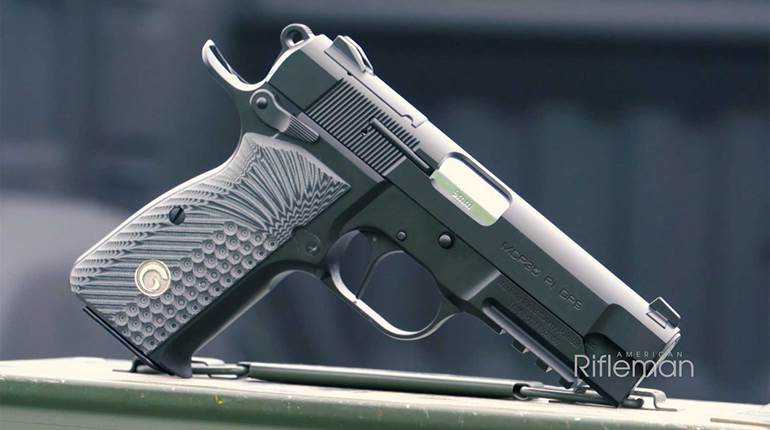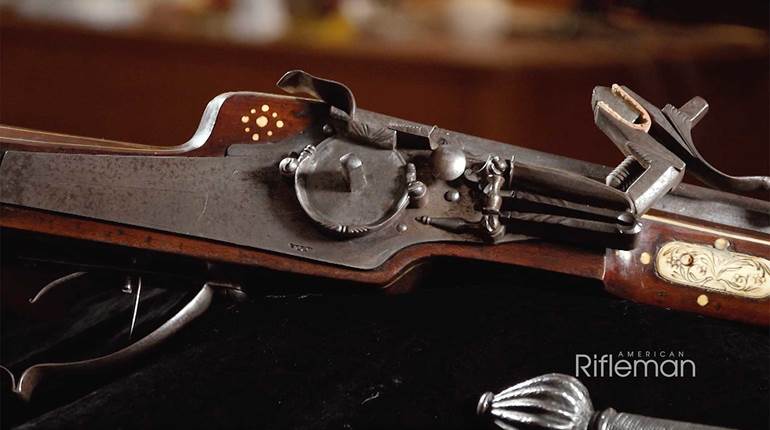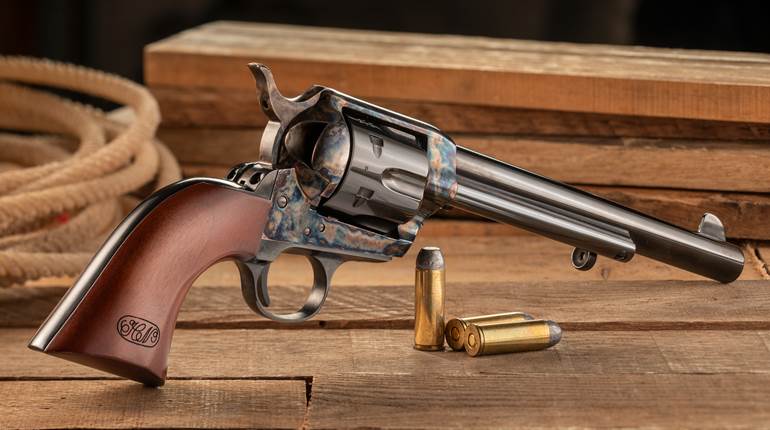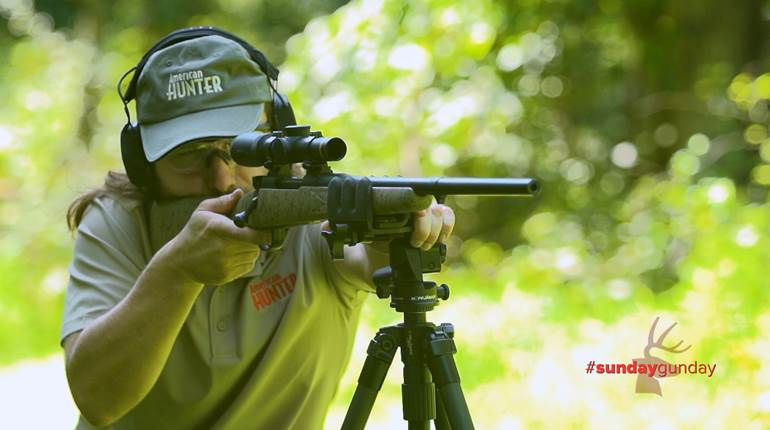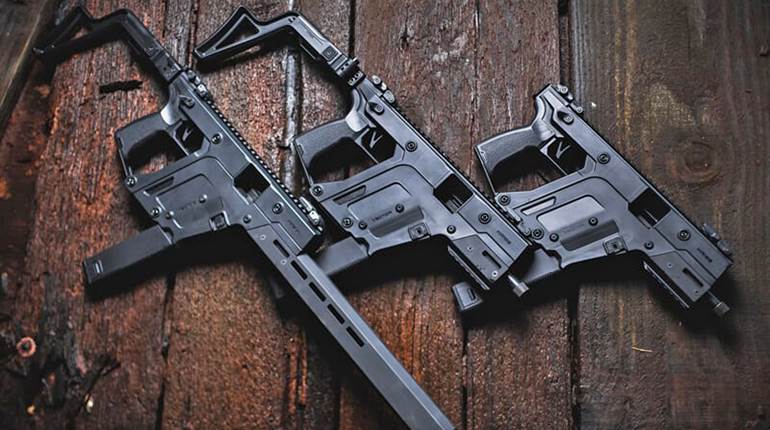
Originally published in the September 1964 issue of The American Rifleman.
Data and CommentRuger Model 10/22 Carbine Sporting arm is neat, compact and functional reliable. There are two general types of cal. .22 rimfire rifles in use—the precision target rifle and the sporting rifle. The Ruger Model 10/22 semi-automatic carbine is in the latter class. Chambered for the .22 Long Rifle cartridge, regular or high velocity, it is designed for small-game hunting and informal target shooting. Action is of blowback-operated type, fed by a unique 10-shot detachable rotary magazine.
In blowback-operated arms, the bolt is held shut by its inertia and pressure of closing spring. In the Ruger Model 10/22 carbine, hammer pressure against rear of bolt also retards opening of the breech. The blowback system is feasible in .22 rimfire arms because of the low power of the cartridges used. It eliminates manual operation of the breech mechanism in loading the chamber, and extraction and ejection of the fired case are done automatically. In semi-automatic arms such as this, the gun fires with each pull of the trigger. A disconnector in the trigger mechanism prevents firing of more than one shot with a single trigger pull.
Externally the Ruger Model 10/22 carbine resembles the Ruger semi-automatic cal. .44 Magnum carbine introduced in 1961. However, their operating mechanisms differ greatly. Receiver and trigger guard of the Model 10/22 carbine are made from lightweight alloy die castings. The steel barrel is attached to the receiver by an ingenious V-block arrangement and two longitudinal screws which draw the barrel up tightly against the receiver face. (The barrel tenon is not threaded into the receiver.) This is a semi-permanent attachment, and removal of the barrel from the receiver is not recommended in routine cleaning.
One of the more interesting features of this gun is its detachable-box magazine. Outer casing of the magazine is plastic, but the magazine throat is a steel investment casting. A spring-driven plastic rotor in the magazine moves the cartridges into feed position. Rotor spring pressure is light, and cartridges can be loaded into the magazine with surprisingly little effort.
Disassembly of the magazine for routine cleaning is simple. The maker suggests that this be done after firing 500 rounds or so, since accumulated powder residue may interfere with proper functioning. To avoid trouble in reassembly, the magazine rotor spring should not be detached from the rotor. Procedure for retensioning the rotor spring is given in the direction sheet furnished with the gun. Base of the inserted magazine lies flush with front end of the trigger guard, a design feature enhancing the clean lines of this gun. The magazine is removed by depressing a thumb latch in the front end of the trigger guard. The user soon acquires the knack of depressing the magazine latch and removing the magazine with one hand.
For reasons of safety a latch is provided to hold the bolt open. This latch is also in the forepart of the trigger guard and is operated with the thumb. In use, the bolt is retracted and the latch is then depressed to engage it. The latch must be depressed again to release the bolt; it does not release automatically by manual retraction of the bolt as in certain other arms. This is an additional safety feature preventing inadvertent release of the bolt and subsequent loading of the chamber if the gun is dropped or jarred. In NRA test, butt of the gun was struck several times against an asphalt-tiled concrete floor, but the latch did not jar off.
Safety is of trigger-locking type with sliding cross-bolt in front portion of the guard loop. When button is in fire position, a red warning line around the button is exposed. Safety cannot be operated unless lock mechanism is cocked. Bolt can be retracted to unload chamber when safety is engaged.
The trigger guard assembly is detached from the receiver by drifting out two pins. Bolt is retained in the receiver by the bolt stop pin which spans rear of the receiver. Removal of this pin is not recommended. Bolt and interior of receiver are exposed sufficiently for cleaning when trigger guard assembly has been detached.
The bolt strikes the bolt stop pin at the end of its rearward travel. A horizontal groove in the rear face of the bolt has a camming surface which tips end of the bolt down slightly when it impacts against the bolt stop pin. This cushions blow of the bolt against the pin and also causes it to rebound less sharply. The delay factor introduced by this action gives the fresh cartridge adequate time to rise into the magazine feed lips. Otherwise, as it returns to battery, the bolt could override the cartridge in the magazine. Tension of the magazine rotor spring can be light by reason of this delay factor. This eases insertion of cartridges into the magazine.
The barrel is chambered tightly to reduce blowback of powder gases and burning powder grains around the side of the cartridge case in extraction. This can be annoying in blowback-operated arms, especially when the ejection port is on the right side of the receiver and the shooter fires from the left shoulder. Barrel and action assembly is secured in the stock by a barrel band and a screw entering bottom of the receiver. Receiver is bedded full-length in the stock. There is no recoil lug, but rear face of receiver abuts the stock mortise. The trigger guard tang has a firm bearing against the stock. Barrel is bedded in the stock at the fore-end tip.
The stock is dense-grained, oil-finished American walnut with full fore-end and pistol grip. The curved, rifle-style steel buttplate is secured to the stock by large screws in toe and upper tang. Proportions of the stock are excellent.
A total of 1,200 rounds was fired in the main series of functioning tests. Six makes and 15 brands of standard-velocity and high-velocity ammunition were used. There were no malfunctions. This is exemplary performance considering that neither the gun nor its magazine were cleaned or lubricated during test.
Accuracy firing was done from machine rest at 50 ft. with both match-grade and high-velocity ammunition. Results were as follows:
Results with both types of ammunition were within the manufacturer’s minimum standard which calls for a 10-shot grouping capability not exceeding 4" extreme spread at 100 yds.
Overall performance of this rifle was excellent. It is neat, compact, and functionally reliable. It is perhaps handicapped by its open sights, but receiver is drilled and tapped for standard telescope mounts. Trigger pull is about 7 lbs., but let-off is crisp after initial slack is taken up. Finish on wood and metal parts is above average. Receiver, trigger guard, and barrel band are anodized matte black. Barrel and buttplate of the 10/22 are blued.
Manufactured by: Sturm, Ruger & Co., Inc.,Southport, Conn.
—NRA TECH. STAFF
Ruger Model 10/22 Carbine (September 1964)
Mechanism Type: detachable-box magazine, blowback-operated, semi-automatic
Grade: standard
Caliber: .22 long rifle, regular or high velocity
Weight: 5 lbs.
Barrel Length: 181⁄2"
Over-All Length: 367⁄8"
Magazine Capacity: 10 rounds
Stock Dimensions: length of pull 131⁄2", drop at comb 111⁄16", drop at heel 23⁄4"
Sights: gold-bead front, folding-leaf U-notch rear, adjustable for elevation
Sight Radius: 153⁄16"
Rifling: six-groove, RH twist
Price: $54.50 (extra magazines $4 each)
































